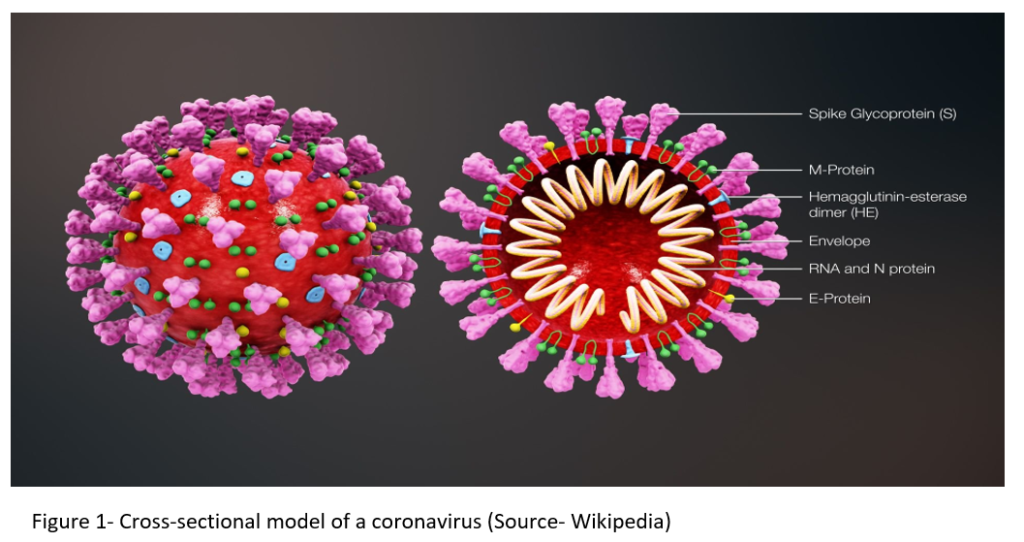
- The Virus that is causing so much fear nowadays and is responsible for millions of deaths all around the world is commonly called the corona virus. Corona virus belongs to family Coronaviridae under order Nidovirales. They are large, lipid enveloped, positive sense, single stranded RNA viruses.
- Corona viruses are found in avian and mammals. Both are similar in chemical structure and morphology. In animals, they can infect and invade different tissues. However, in human they primarily infect respiratory system. It has been proposed that the ancestor of many mammalian coronaviruses may be bat coronavirus.
- Human coronaviruses (HCoVs) represent a major group of coronaviruses (CoVs) associated with multiple respiratory diseases of varying severity. HCoVs are regarded as most rapidly evolving viruses due to their recombination and high genomic nucleotide substitution rates.
Known types of human corona virus
- Human coronaviruses were first identified in 1960s. Till today, there are seven known human corona viruses that infect people. These seven includes:
The common human corona viruses
- 229E (alpha coronavirus)
- NL63 (alpha coronavirus)
- OC43 (beta coronavirus)
- HKU1 (beta coronavirus)
Other human corona viruses
- Middle East Respiratory Syndrome Corona Virus (MERS-CoV)
- Severe Acute Respiratory Syndrome Coronavirus (SARS-CoV) and
- SARS-CoV-2, the latest coronavirus that causes corona virus disease19 or COVID-19.
- Among these, four HCoVs (HCoV-229E, HCoV-NL63, HCoV-oc43, HCoV-HKU1) are found worldwide in human beings and are responsible for one-third of common cold infections in whole world. They can cause mild to moderate illness of upper respiratory tract. However, the condition may be serious in people with weak immune system and cardiopulmonary disease.
- Sometimes, corona viruses which infect animals can evolve and if transmitted to humans, can become novel human corona virus. Three recent examples of such cases are MERS-CoV, SARS-CoV and SARS-CoV-2.
Severe Acute Respiratory Syndrome (SARS)
- Coronavirus were not much popular until 2003 though they cause mild upper respiratory tract infections. This changed dramatically in 2003 when SARS-CoV first emerged in China. Its symptoms were atypical pneumonia, fever, headache and cough which may progress into respiratory failure and acute respiratory distress syndrome.
- It spread across 32 countries and infect more than 8000 individuals with mortality rate of about 10 %. It spreads through respiratory droplets when infected person coughs or sneezes. Most cases of transmission was noticed in health care settings, mostly with no adequate infection control.
- SARS-CoV was found to be more stable than any other human respiratory virus like respiratory syncytial virus. It survives for many days when dried on surfaces and in feaces at an alkaline pH.
Middle East Respiratory Syndrome (MERS)
- The MERS-CoV epidemic happened in Saudi Araba in 2012. Its symptoms were similar to SARS-CoV but mortality rate was high about 30 %. Most of the cases of MERS were seen in countries of Arabian Peninsula. The largest known outbreak of MERS outside Arabian Peninsula was in Republic of Korea in 2015 which was associated with a traveler returning from Arabian Peninsula
- Its human transmission has been limited as it is not passed easily from one person to another. There have been 2,494 laboratory-confirmed cases of MERS from 27 countries, resulting in 858 deaths since first reported case of MERS-CoV.
- MERS patient are of different age ranging from younger than 1 to 99 years old.
COVID-19 (recent reported form of corona virus)
- It was first reported at the end of 2019 in Wuhan, China. Since then, it has rapidly spread across the world affecting more than 3 million people. It was declared as pandemic by WHO on March 11, 2020.
- The severity of disease is found more in elderly patient and in presence of comorbidities.
- Different drug candidates including vaccines and antiviral drugs are being researched and are in various phases of clinical trials. Remdesivir from Gilead Sciences is the only drug approved for emergency use in COVID-19 by FDA till today’s date.
Structure of corona virus

- Coronavirus are roughly spherical or moderately pleomorphic (changeable in shape) with club like projections. The viral envelope is a lipid bilayer in which membrane (M), envelope (E) and spike proteins are anchored. There are around 70-75 surface spikes in one coronavirus
- Inside, there is a helically symmetrical nucleocapsid enclosing a single stranded RNA of large size about 26-32 kilobases.
- The genomic RNA acts as a messenger RNA (mRNA) consisting of 5’ terminal cap structure and a 3’pply A tail. This genomic RNA acts in three different forms during whole life cycle of virus: as an initial RNA of infectious cycle, as a template for replication and transcription and as a substrate for packaging into progeny virus.
References
- https://www.who.int/emergencies/mers-cov/en/
- https://www.who.int/ith/diseases/sars/en/
- Peiris J, Yuen K, Osterhaus A, Stohr K. The Severe Acute Respiratory Syndrome. N Engl J Med. 2003; 349:2431-2441.
- Khan IH, Zahra SA, Zaim S, Harky A. At the heart of COVID-19. J Card Surg. 2020 May 5.
- Medical Microbiology. 18th edition. Page no-587-593.
- Fenner and White’s Medical Virology. 5th edition. Page no- 437-446.
- Lim YX, Ling Y, Tam JP, Liu DX. Human Coronaviruses: A Review of Virus–Host Interactions. Diseases. 2016 Sep; 4(3): 26.